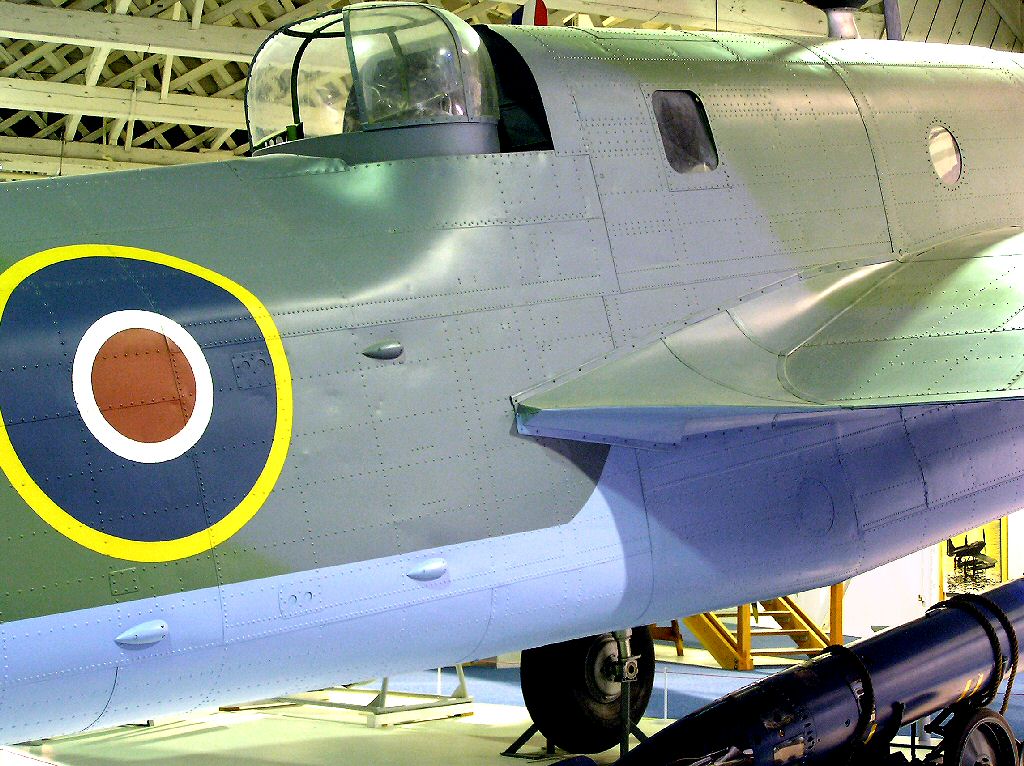|
The Bristol Beaufort carried out the role of mine layer, dropping magnetic mines up until 1943. Bristol Beaufort torpedo bombers saw active service over the English Channel, the North Sea and the Atlantic. In order to launch torpedos the strategy required the pilots to make an approach at relatively high altitude to avoid damage by anti aircraft fire from hostile ships and when very close to the target, go abruptly into a steep power dive to descend swiftly down to sea level and then discharge the torpedo.
As Bristol Beaufort torpedo bomber units experienced combat and suffered losses the pilots complained that the Beaufort’s armament was inadequate. Extra .303 in (7.7 mm) machine guns were fitted; two on a gimbal mounting in the forward nose and single guns on pivots on either beam. A remotely controlled .303 in (7.7 mm) Browning machine gun was fitted, firing to the rear under the nose. Housed in a clear blown transparency, it was found to be of little use and soon discarded.
The Maximum speed of the Beaufort was 271.5 mph (420 km/h) at 6,500 ft (1,981 m). It had a cruising speed of 255 mph at 6,500 ft (221 kn, 410 km/h) at 6,500 ft (1,981 m) with a range of 1615 miles (2,600km). the Bristol Beaufort had a Service ceiling of 16,500 ft (5,030 m).
In 1942 they were posted to the Indian Ocean and the Mediterranean. The Malta based Bristol Beauforts were very successful in sinking
Rommel's supply ships that helped the Allies win the war in North Africa. 1380 Beauforts were produced and that includes the 700 that were built in Australia.
The Bristol Beaufort also flew as a bomber as well as a torpedo Bomber. Beauforts were used, by the Royal Australian Air Force in the Pacific theatre right up until the end of the Second World War.
On 30th January 1945 No 100 Squadron was given the job of destroying a Japanese Anti-Aircraft gun position on a hill behind the enemy Wewak Airstrip and a fuel depot. The plan was for most of the squadron to bomb the gun position from a height of 6,000 feet after Wing Cdr John W Kessey flying RAAF Bristol Beaufort A9-616 dropped a smoke bomb on top of the target to assist the Squadron locate and concentrate their bombing on the Anti-Aircraft gun position. Wing Cdr John W Kessey flew at tree top height on the ridge just south of the target. He flew as low as possible to avoid detection and successfully released smoke bomb on the Japanese heads. The high explosive bombs followed and smashed the site killing all the gun crews apart from one soldier, Gunnery Officer Lt. Taizo Takahashi. (Kessey later met him in Kyoto in 1976)
As the Bristol Beaufort A9-616 cleared the target ground fire took out its starboard engine. Wing Cdr John W Kessey feathered the starboard airscrew, applied maximum power on the port engine and climbed as high as he could with the high speed he had. Instead of heading straight back home he flew to the next target on the Eastern part of Muschu Island just off Wewak Point.
The bomb bay doors were opened on at the last moment to reduce air resistance that would effect the Beaufort airspeed. The bombs were released over the second target and caused huge explosions and bursts of flames and fire erupting from the barrels of aviation and diesel fuel. For once the intelligence report was correct. Wing Cdr John W Kessey managed to get the crippled plane back the squadron’s base at Tadji.
On 29th July 1942 RAAF Flying-Officer Doug Avery of 100 Squadron based at Laverton, attacked and sank a Japanese submarine in 70 ft. of water in Disaster Bay, off the
Australian NSW south coast in his Bristol Beaufort. The RAAF crews lived in tents on the airstrip and used the local hotel for washing and hot showers. There was a clear bright moon that night and one of the aircrew suggested that the squadron went out to hunt Jap subs that had surfaced to recharge their batteries using night as cover.
Each Beaufort was assigned a search area 40 miles out to sea by 60 miles along the coast. Avery was given the centre sector, which included the Disaster Bay area. Doug Avery saw a submarine silhouetted in the moonlight. He had on purpose flown towards the moon in his search pattern so that any sub would stand out. As the sub would be recharging its batteries it was hoped that the noise of its engines would cover the approach of the Bristol Beaufort. Obviously they had good lookouts posted as the sub started to crash dive. Doug pulled away, then came in low and released his six 2501b anti-submarine bombs over the target. He certainly hit the sub because the shrapnel from their blast peppered his wings.
These aircraft photographs are great reference sources if your painting 1/72 scale, 1/48 scale or 1/24 scale plastic model airplane Airfix, Tamiya, zvezda, revel, Pavala aircraft kits or you’re into flying and painting radio RC controlled model planes.
There are many aviation books published about the Bristol Beaufort torpedo bomber pictures
www.MooreAircraft.com
Tell your friends about us. Send them an e-mail
|
